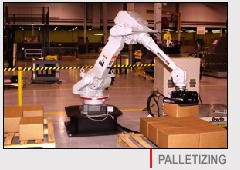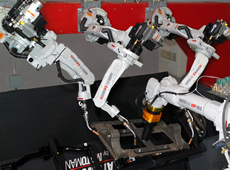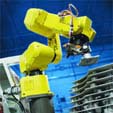AMAZON multi-meters discounts AMAZON oscilloscope discounts
The concept of how robots and other automated equipment should be used in industry has changed radically since the 1970s and 1980s when robots were first introduced into U.S. industry on a large scale. In the early 1980s most U.S. companies thought robots would be the answer to high labor cost and low production. Many companies had visions of replacing large numbers of workers with a robot that would be paid for in a few years and then work for free. What occurred nearly ended the "high-tech" automation revolution before it got started. The first robots that were installed did not match the application they were designed for, they broke down frequently, and they were difficult to program. This meant that three to five extra skilled workers (electronic technicians, electricians, machinists, programmers) were needed to keep each robot running. Since robots broke down frequently, large amounts of downtime occurred and production schedules became unpredictable. Most robots were selected on the basis of return on investment (ROI) instead of what application they were to perform. This meant robots were being specified and purchased by the accounting department rather than by the people who understood the technology. In the middle of the 1980s nearly 100 companies were manufacturing and selling robots. At this time robots were sold like used cars and they were shipped to the industrial site with no programs installed, no end effectors, and no integration to other technology. This meant that the factory that purchased the robot needed to supply this technology or the new robot would sit in the corner.
In the late 1980s it became apparent that robots were actually an extension of present automation and that they must be integrated with existing human workers and existing automation to be successful. The number of companies manufacturing and selling robots began to combine until less than 25 of the best survived. Today the robot manufacturers work closely with technical systems houses to make sure their robots are programmed and integrated with their applications when they arrive on the factory floor. These systems are called turnkey systems because the factory personnel can simply turn the system on and run it after it has been installed and integrated and they don't need the high level of technology required to install , program, and integrate the robots.
Today robots are selected for the application they perform, the type of interface they provide to other systems, and the type of programming they use. If a robot can do a job, but it's difficult to change its program, it won't survive in a small company where an outside programmer is required each time a programming change is needed. If a robot can do the job, but it can't be interfaced with existing machines or other automation, it won't be useful. Most robots today perform jobs that are unsafe for humans such as lifting heavy parts, spot welding, loading and unloading presses where moving parts can injure a person, welding or painting where fumes cause long-term health problems to humans, and jobs that require a high degree of speed or accuracy such as inserting parts in a printed circuit board, continuous welding, and painting. ill. 1 shows examples of several types of modern robotic applications.
 |
 |
 |
 |
Above: ill.1: Images of varoius, modern industrial robots.
Today robots are thought of in the same terms as every other piece of equipment on the factory floor: Is it reliable, easy to integrate, easy to change its task as new products change, and easy to troubleshoot and repair to keep downtime to a minimum? If it's unreliable, it's no better than a conveyor with a worn belt that always breaks, or a hydraulic press that always leaks. The fact that many robots perform a more complex task is generally secondary when it's compared to other equipment in the process. The modern robot must be highly reliable and accurate, easy to program or change its program, and easy to interface to other machines it works with.
If you're electronics technician, you will think of the robot in the same terms as any other electronically controlled machine on the factory floor. You will be expected to start it up, jog it, make simple program changes, test its input and output signals, and troubleshoot its electronic boards.
Robots can be categorized by the type of configuration of their arms (cylindrical, rectilinear, spherical, or jointed spherical) or they can be categorized by the type of drive (ac motors, dc motors, air cylinders, or hydraulics). They can also be categorized by the job they perform (palatizing, welding, spray painting, assembly, and so on) or by their size (small, medium, or large). Since some robots don't fit completely into one category, it becomes difficult to classify them, which brings a certain amount of confusion. It's best to think of these types of classifications as general in nature and not be worried when a specific robot application doesn't fit exactly.
| Top of Page | PREV: Industrial Robotics | NEXT: |